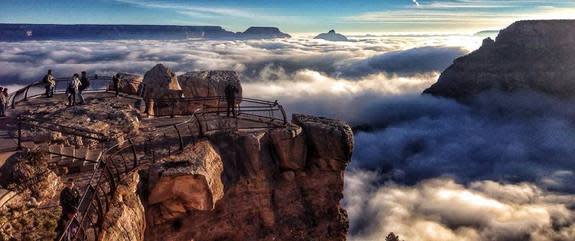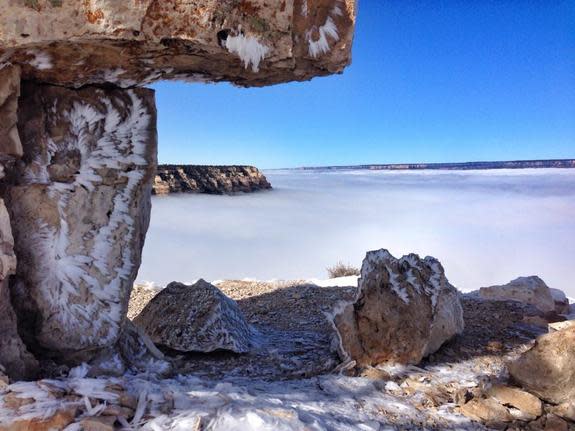Rare Weather Event Fills Grand Canyon with Fog
Usually the Grand Canyon offers stunning views stretching for miles, deep into valleys etched by the Colorado River. But that vista has changed over the past few days, as a rare weather event has filled the canyon with fog, offering an even more stunning view than is typical.
The weather event is known as a temperature inversion, and it only happens every few years, according to the National Park Service, who wrote about the event and posted photos of it on its Facebook page.
Temperature inversions typically happen in the winter when there are long nights, and as the name implies, an inversion takes place when a layer of cool air gets trapped underneath warmer air, according to the National Weather Service (NWS). This is the reverse of the usual pattern, with temperature generally decreasing with increasing altitude. [See Amazing Photos of the Grand Canyon]
"Once the sun goes down, the ground loses heat very quickly, and this cools the air that is in contact with the ground," the NWS explained. "However, since air is a very poor conductor of heat, the air just above the surface remains warm. Conditions that favor the development of a strong surface inversion are calm winds, clear skies, and long nights," which is exactly what's taking place in the Grand Canyon now, according to weather reports.
"Calm winds prevent warmer air above the surface from mixing down to the ground, and clear skies increase the rate of cooling at the Earth's surface," the NWS continued. "Long nights allow for the cooling of the ground to continue over a longer period of time, resulting in a greater temperature decrease at the surface."
If moisture is trapped in this layer, it can form fog, as happened in this case. So far the inversion has taken place on two of the past three days in the Grand Canyon, which rarely happens, especially on days with blue, clear skies, the NPS wrote.
The Grand Canyon, which wends 277 miles (446 kilometers) along a sinuous path, became a national park in 1919; at that time some 44,173 visitors enjoyed the billions of years of history tucked into its colorful rocks. That's compared with the nearly 5 million visitors to the park today, according to NPS.
Email Douglas Main or follow him on Twitter or Google+. Follow us @livescience, Facebook or Google+. Article originally on LiveScience.
Copyright 2013 LiveScience, a TechMediaNetwork company. All rights reserved. This material may not be published, broadcast, rewritten or redistributed.



